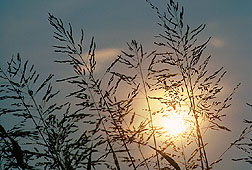SMUT—Not Always a Bad Word in Sugarcane Country
|
|
During a time when most concerned citizens want to wipe out smut, Rex W. Millhollon is trying to encourage it.
His campaign isn't over freedom of speech. Instead, the respected agronomist is studying new ways to fight a noxious southern weed with a lethal dose of smut—loose kernel smut, that is.
Sphacelotheca holci, as it's called scientifically, is a natural fungus that attacks johnsongrass, a perennial weed that plagues many crops.
In Louisiana's bayou country, where Millhollon conducts his research, sugarcane growers rely on herbicides to rid their fields of the pesky grass. But this raises concerns over the potential buildup of chemical residues in the environment. Cost is another concern, says Millhollon, who is in the Agricultural Research Service's Sugarcane Research Unit at Houma, Louisiana.
Cane growers spend up to $50 per acre applying herbicides, an expense they anticipate recovering through increased sugar yields. But each season, they must renew the fight, drawing on the chemicals once again.
Now, Millhollon is exploring smut's biological control potential to break that cycle.
One of the weed's few known pathogens with mycoherbicide potential, the S. holci fungus infects the seedhead, turning its reproductive structure into a crumbly, black mass. Yet, its ability to attack only johnsongrass and related sorghum species keeps this smut from exacting a similar toll on other grass crops like sugarcane and wheat, which succumb to other species of smut. Most sorghum cultivars were found resistant to loose kernel smut of johnsongrass, but a few can become infected.
"It's an obligate parasite that can only complete its life cycle on the host plant," says Millhollon.
"In nature, when wind-blown spores come in contact with the johnsongrass host and germinate, the hyphae enter the plant, colonize growth tissue in the tips of buds, stems, or rhizomes, and complete the fungus' life cycle by producing spores in the reproductive tissue of newly formed seedheads," he says.
"If you can get it to infect the whole plant, the fungus will stunt its growth, reducing competitiveness with sugarcane and cutting down on the production of seed that, if dispersed, can remain viable in soils for many, many years."
In greenhouse experiments with johnsongrass, Millhollon injected a spore solution of smut directly into the weed's tissues. The result: smutted seedheads and plant infection rates of 75 to 85 percent.
But injection isn't practical under field conditions. So Millhollon used lab culture techniques to grow billions of sporidia, an infectious form of the fungus. This enabled him to formulate a mycoherbicide spray.
Outdoors, Millhollon observed plant infection rates of 50 to 80 percent 40 to 60 days after applying the spray. Though promising, the treatment didn't protect the cane crop as well as conventional herbicides.
"If we inject the spores into the plant, the whole plant becomes infected," Millhollon explains. "But when we spray it in the field, we get only partial infection. So weed growth isn't greatly affected, and we still get a lot of weed seed production."
Greater virulence—or disease-causing ability—he says, may help to overcome the problem. One approach is to breed the fungus with other races of smut that exchange their genes sexually. The trick: ensuring the new breed won't pose a new threat to cereal crops like sorghum.
A more "surgical" approach might be to use biotechnology techniques to increase virulence by manipulating specific fungal genes. In either case, says Millhollon, giving smut a helping hand could "take it to the next level and add one more element to johnsongrass control."—By Jan Suszkiw, Agricultural Research Service Information Staff.
This research is part of Integrated Insect, Mite, and Weed Control, an ARS National Program described on the World Wide Web at: http://www.nps.ars.usda.gov/programs/cppvs.htm.
Rex W. Millhollon is in the USDA-ARS Sugarcane Research Unit, P.O. Box 470, Houma, LA 70361; phone (504) 853-3174, fax (504) 868-8369.
"SMUT—Not Always a Bad Word in Sugarcane Country" was published in the May 1999 issue of Agricultural Research magazine.







